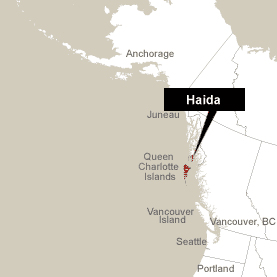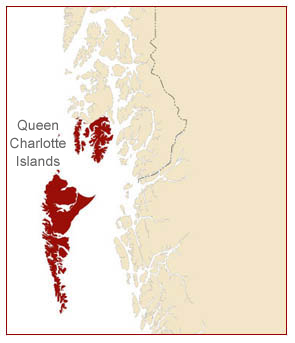
The Haida Gwaii, the Queen Charlotte Islands, are a rich group of islands with breathtaking mountains and valleys located off Canada’s northern British Columbia Coast. For 2,000 years the secluded villages, waterways and majestic forest nurtured the tribe and gave way to a disciplined Haida artistic form that is simultaneously taunt and fluid.
The Haida have traditionally carved with argillite, a rare and beautiful fine grained black silt stone found only in one deposit, the Slate Chuck Creek on the Haidi Gwaii. Nineteenth century Haida crafted pipes for tobacco rituals performed at funerals using this sacred stone. The Haida carved images of dragonflies and butterflies onto these funeral pipes as they were believed to transport the souls of the deceased. The Haida today are the only authorized carvers of argillite and create elegant sculptures reflecting past and present traditions.
Haida villages centered fishing, and they carved large totem poles facing the sea. The Haida were experienced canoe craftsmen, using them as their primary form of transportation. Consequently, Haida canoes are considered a premier water vessel on the Northwest coast. Overall, Haida art offers stunning contrasts in scale: from monumental totem poles, delicate spruce root baskets and hats, and flawlessly detailed engraved argillite jewelry.
 Haida art has survived settlement and changes throughout the region as generations have carried on the disciplined artistic tradition. The Haida art proved to be an integral trade tool with on the influx of European settlers for their detailed basket weaving, beads and other art was sought after.
Haida art has survived settlement and changes throughout the region as generations have carried on the disciplined artistic tradition. The Haida art proved to be an integral trade tool with on the influx of European settlers for their detailed basket weaving, beads and other art was sought after.
Charles Edenshaw, one of the first to gain international recognition for the Haida people, provided an inspiring and unyielding standard of perfection and gave way to subsequent generations of artists. Reg Davidson, Robert Davidson, Isabel Rorick, who comes from a long line of basket weavers; Jay Simeon and the late, great orator and sculptor, Bill Reid.
